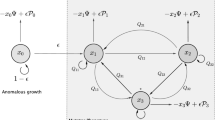Abstract
Human homeostasis is the body’s ability to physiologically regulate its inner environment to ensure its stability in response to changes in the outside environment. An inability to maintain homeostasis may lead to death or disease, which is caused by a condition known as homeostatic imbalance. Normal cells follow the homeostasis when they proliferate and cancer cells do not. This work deals a model consisting of three reaction–diffusion equations representing in vitro interaction between two drugs. One drug inhibits proliferation of cancerous cells, and the other destroys these cells. The growth of in-vitro cancer cells has been studied using two numerical methods: the Predictor–Corrector and the Operator splitting method. A stability analysis of the model is performed with and without diffusion.











Similar content being viewed by others
References
Bellomo, N., Bellouquid, A., Delitala, M.: Mathematical topics on the modelling complex of multicellular systems and tumour immune cells competition. Math. Models Methods Appl. Sci. 14, 1683–1733 (2004)
Bellomo, N., De Angelis, E., Preziosi, L.: Multiscale modelling and mathematical problems related to tumour evolution and medical therapy. J. Theor. Med. 5, 111–136 (2004)
Bellomo, N., Preziosi, L.: Modelling and mathematical problems related to tumour evolution and its interaction with the immune system. Math. Comput. Model. 32, 413–452 (2000)
Byrne, H.M., Preziosi, L.: Modelling solid tumour growth using the theory of mixtures. Math. Med. Biol. 20, 341–366 (2004)
Chaplain, M.A.J., Graziano, L., Preziosi, L.: Mathematical modeling of the loss of tissue compression responsiveness and its role in solid tumour development. Math. Med. Biol. 23, 197–222 (2006)
Ramis-Condie, I., Chaplin, M.J., Anederson, A.R.: Mathematical modelling of cancer cell invasion of tissue. Math. Comput. Model. 47, 533–545 (2008)
Al-Husari, M., Murdoch, C., Webb, S.D.: A cellular automaton model examining the effects of oxygen, hydrogen ions and lactate on early tumour growth. J. Math. Biol. 69(4), 839–873 (2013)
Anderson, A.R.: A hybrid mathematical model of solid tumour invasion, the importance of cell adhesion. Math. Med. Biol. 22, 163–186 (2005)
Turner, S., Sherratt, J.A.: Intercellular adhesion and cancer invasion, a discrete simulation using the extended potts model. J. Theor. Biol. 216, 85–100 (2002)
Muna, M.-J., Kima, J.-H., Choi, J.-Y., Janga, W.-C.: Calcium homeostasis modulator 1 gene P86L polymorphism and the risk for alzheimer’s disease: a meta-analysis. Neurosci. Lett. 619, 8–14 (2016)
Murray, J.D.: Mathematical Biology I: An Introduction, 3rd edn. Springer, New York (1993)
Dey, S.K., Amato, U.: Numerical modeling of in vitro inhibition of mutation of cancer cells, CNR reports (2002), RT258, http://www.cnr.it
McNabb, A.: Comparison and existence theorems for multicomponent diffusion systems. J. Math. Anal. Appl. 3, 133–144 (1961)
Pachpatte, B.G.: On nonlinear coupled reaction–diffusion equations. Appl. Math. Comput. 16, 297–307 (1985)
Pao, C.V.: Reaction diffusion equations with nonlinear boundary conditions. Nonlinear Anal. 5, 1077–1094 (1981)
Pao, C.V.: On nonlinear reaction–diffusion systems. J. Math. Anal. Appl. 87, 165–198 (1982)
Dey, S.K.: Computational modeling of the breast cancer treatment by immunotherapy, radiation and estrogen inhibition. Sci. Math. Jpn. Online 8, 283–292 (2003)
Ascher, U.M., Ruuth, S.J., Wetton, B.T.R.: Implicit–explicit methods for time-dependent partial differential equations. SIAM J. Numer. Anal. 32, 797–823 (1995)
Ascher, U.M., Ruuth, S.J., Spiteri, R.J.: Implicit–explicit Runge–Kutta methods for time-dependent partial differential equations. Appl. Numer. Math. 25, 151–167 (1997)
Schiesser, W.E., Griffiths, G.W.: A Compendium of Partial Differential Equation Models: Method of Lines Analysis with Matlab. Cambridge University Press, Cambridge (2009)
Vande Wouwer, A., Saucez, Ph, Schiesser, W.E.: Adaptive Method of Lines. CRC Press, Boca Raton (2001)
Johnson, C.: Numerical Solutions of Partial Differential Equations by the Finite Element Method. Cambridge University Press, Cambridge (1987)
Boyd, J.P.: Chebyshev and Fourier Spectral Methods. Dover (2001). http://depts.washington.edu/ph506/Boyd
Fornberg, B.: A Practical Guide to Pseudospectral Methods. Cambridge University Press, Cambridge (1996)
Haq, S., Bibi, N., Tirmizi, S.I.A., Usman, M.: Meshless method of lines for the numerical solution of generalized Kuramoto–Shivashinsky equation. Appl. Math. Comput. 217(6), 2404–2413 (2010)
Mohyud-Din, S.T., Negahdary, E., Usman, M.: A meshless numerical solution of the family of generalized fifth-order Korteweg-de Vries equations. Int. J. Numer. Methods Heat Fluid Flow 22(5), 641–658 (2012)
Al-Khaled, K.: Numerical study of Fisher’s reaction? Diffusion equation by the Sinc collocation method. J. Comput. Appl. Math. 137(2), 245–255 (2001)
Brian, P.L.I.: An infinite difference method of high order of accuracy for the solution of three-dimensional heat conduction problems. AIChE J. 7, 367–370 (1961)
Dey, S.K., Dey, C.: An explicit predictor–corrector solver with applications to burgers’ equation, NASA Technical Memo 84402, September (1983)
Farago, I., Havasiy, A.: Operator Splittings and Their Applications. Nova Science Publishers, New York (2009)
Ladics, T.: Application of operator splitting to solve reaction–diffusion equations. Electron. J. Qual. Theory Differ. Equ. 9, 1–20 (2012)
Geiser, J.: Decomposition Methods for Differential Equations,Theory and Applications. Chapman Hall, CRC Press, London (2009)
Sapoukhina, N., Tyutyunov, Y., Arditi, A.: The role of prey-taxis in biological control. Am. Nat. 162, 61–76 (2003)
Chakraborty, A., Singh, M., Lucy, D., Ridland, P.: Predator-prey model with prey-taxis and diffusion. Math. Comput. Model. 46, 482–498 (2007)
Samsuzzoha, M., Singh, M., Lucy, D.: Numerical study of an influenza epidemic model with diffusion. Appl. Math. Comput. 217, 3461–3479 (2010)
Singh, M., Easton, A., Cui, G., Kozlova, I.: A numerical study of the two-dimensional spruce-budworm reaction–diffusion equation with density dependent diffusion. Nat. Res. Model. 11, 143–154 (1998)
Acknowledgments
We thank the editor and anonymous reviewers for their constructive comments, which helped us to improve the manuscript.
Author information
Authors and Affiliations
Corresponding author
Rights and permissions
About this article
Cite this article
Usman, M., Flora, G., Yakopcic, C. et al. A Computational Study and Stability Analysis of a Mathematical Model for In Vitro Inhibition of Cancer Cell Mutation. Int. J. Appl. Comput. Math 3, 1861–1878 (2017). https://doi.org/10.1007/s40819-016-0201-8
Published:
Issue Date:
DOI: https://doi.org/10.1007/s40819-016-0201-8



